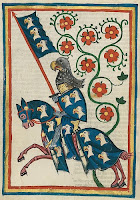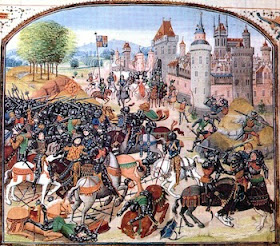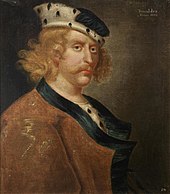After the story of
Gregorius by
Hartmann von Aue, I became curious if there ever was a pope who was the product of incest. The only pope I could find with any connection to incest was John XII, who was called Octavian at birth and probably should never have become pope.
His father was Alberic II of Spoleto (912 - 954). Alberic styled himself Prince of Rome, and for all intents and purposes, he controlled Rome politically after a quarrel with the actual King of Rome, Hugh, when Alberic incited a mob that drove Hugh out of the city. Alberic married his step-sister Alda, which would (sort of) make their son the product of incest. But their son was Gregory I of Tusculum. Octavian's mother was actually Alberic's concubine. On Alberic's deathbed, he had the nobles and clergy of Rome swear to make Octavian the next pope (Gregory was a count, and didn't need anything else).
This idea was not completely out of the blue. Octavian had entered holy orders and was a cardinal deacon of a basilica in Rome. Pope Agapetus II died in November 955, and the 25-year-old Octavian was elected his successor one month later, taking the name John XII.
A note about the name: for centuries, popes used their own names when elected; they rarely took a new name when they became pope. When Octavian chose to call himself "John" it was only the third time that a pope took a new name. This is called a "regnal name"; that is, the name used when one starts a reign or pontificate. The only other times prior to this when a pope used a different name were John II (born Mercurius, reigned 533-535) and John III (born Catelinus, reigned 561-574). Octavian would use 'Octavian" when issuing directives on secular matters, and "John XII" when issuing papal bulls.
There were plenty of secular issues. In 960 he personally led an attack on some Lombard duchies to reclaim part of the Papal States. He did not achieve that goal, and in fact had to agree to relinquish a claim on certain territories. He was equally ineffective in controlling Rome the way his father had. When King Berengar II of Italy began to attack papal territory, John appealed to Otto I "the Great" of Germany. For his help, John crowned Otto Holy Roman Emperor.
At home, John was considered coarse and immoral; the Lateran Palace was described as a brothel. At a Synod of Rome in 963, charges of corruption were brought against him. The contemporary priest and historian Liudprand of Cremona offers us this (hearsay) account:
Then, rising up, the cardinal priest Peter testified that he himself had seen John XII celebrate Mass without taking communion. John, bishop of Narni, and John, a cardinal deacon, professed that they themselves saw that a deacon had been ordained in a horse stable, but were unsure of the time. Benedict, cardinal deacon, with other co-deacons and priests, said they knew that he had been paid for ordaining bishops, specifically that he had ordained a ten-year-old bishop in the city of Todi ... They testified about his adultery, which they did not see with their own eyes, but nonetheless knew with certainty: he had fornicated with the widow of Rainier, with Stephana his father's concubine, with the widow Anna, and with his own niece, and he made the sacred palace into a whorehouse.
I have italicized the relevant phrase. (I promised an incestuous pope, after all.)
It was his deal with Otto that ultimately caused him trouble. Otto wanted John to abandon his worldly ways. As Otto did what John wanted—subduing Berengar—John feared Otto's hold in Italy and sent for help from the Magyars and the Byzantines. Seeing John turn on him, Otto besieged Rome. John fled Rome, taking papal treasure with him. A council summoned in Rome by Otto deposed John and elected Pope Leo VIII in his place.
After Otto left Rome, John re-entered (Leo fled) and summoned his own synod to declare his deposition invalid. Before he could negotiate with Otto, he died on 14 May 964. The cause of his death is uncertain. All accounts say it involved an adulterous encounter, but some say he died of apoplexy and some say he was caught and killed by the husband.
His very worldly behavior may explain a papal legend that won't go away. A medieval writer claims that among John's concubines was one named Joan who wielded great authority during John's pontificate. It has been suggested that this gave rise to the legend of "Pope Joan," that supposedly there was a pope who was secretly a woman—a claim for which no evidence exists. But I suppose that legend is worth examining next time.

























